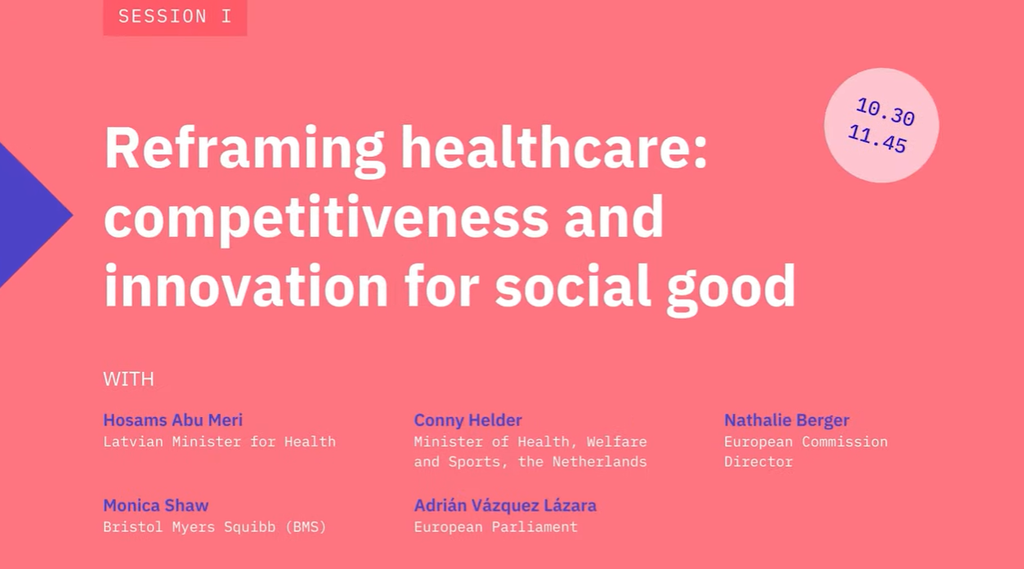Europe's moment: advancing clinical research and health innovation
Next event In person & online

- Area of Expertise
- Sustainable Livelihoods
Sustainable Livelihoods

Minister for Health, Latvia
It’s not easy for European policymakers to stay ahead of the game in the face of today’s challenges. There are the high-profile external pressures from conflicts in Ukraine, Iraq and Syria, to the more distant yet hugely threatening Ebola virus. At the same time, the 28 member states of the European Union are confronting internal health challenges posed by the ageing population and related chronic rises in non-communicable diseases.
The number of such priority health issues has grown rapidly in recent years, with no sign that they are likely to be solved soon. Faced with these challenges, the EU has to prioritise its investment goals for the coming years and balance those priorities with rising public expectations generated by healthcare technology advances. Modern medicine is benefitting greatly from digitalisation, nanotechnologies and synthetic materials, as well as a greater understanding of stem cells, tissue engineering and printing. However, we need to properly discuss the ethics involved and decrease patient anxiety about the possible risks of innovative medical intervention. Personalised medicine is also increasingly becoming a subject of discussion, with calls for earlier and more accurate diagnoses and safer, better-targeted treatments reducing the risk of side-effects.
Two of today’s greatest challenges are integrating health systems and interdisciplinary cooperation. These are crucial in the context of the ageing population and chronic diseases where EU member states need to find one systemic solution. That cannot be accomplished without proper information exchange between countries. As Simone de Bruin and her colleagues at the National Institute for Public Health and Environment in the Netherlands outlined in their 2012 paper, treatment of patients with multiple non-communicable chronic conditions requires the creation of multidisciplinary teams through a comprehensive merging of specialist knowledge and skills. Such cases also demand cooperation between international organisations to share expertise. The EU needs a long-term, comprehensive and evidence-based strategy drawn from the World Health Organisation’s health-in-all-policies approach. It may even be time to give legal status to such an approach that would improve the value and effectiveness of health spending.
Two of today’s greatest challenges are integrating health systems and interdisciplinary cooperation
At the EU level, it is important to strengthen the effectiveness of health systems, increasing the accessibility of healthcare and improving the resilience of health systems. Bringing these elements together will require increased cooperation on health technology assessment e-health and m-health (using mobile devices for medicine and public health). This would bring easier access to health information, raise efficiency and help prevent citizens becoming patients. The European Commission recognised the importance of this issue in its e-health Action Plan 2012-2020. Both e-health and m-health deliver more personalised healthcare solutions and improve interaction between patients and medical staff, while including patients in the decision-making process.
Another challenge is improving the cross-border compatibility of information, including statistics. The Commission already supports the development of European Core Health Indicators (ECHI). This must be accompanied by an improvement in indicator definitions to provide credible data flows and international verification. An effort must also be made to improve the Automated Classification of Medical Entities (ACME) programme based on the International Statistical Classification of Diseases and Related Health Problems. The WHO has started this process, but the Eurostat’s Technical Group on Causes of Death Statistics recommends changing to a new system named IRIS for the messenger goddess of Greek mythology. A problem with ACME has been incorrect coding algorithms, decried by many doctors. This is substantially, though not entirely, eliminated in IRIS and users will be able to report any further irregularities directly to the developers. The challenge for member states is to integrate the new system into the existing mortality registries, but there is not yet enough information on which algorithms are most dependable for each diagnosis group. At present, the EU’s plan for health statistics is to ensure the information will be compatible in all countries.
The European Commission’s top task should be to support measures that address health inequities within and between member states
It is possible to improve the prevention, monitoring and treatment of non-communicable diseases while at the same time strengthening outpatient care and making systems less hospital-centred. At EU-level, this was stressed in 2013 when 11 member states strengthened their healthcare reform processes. Capital investments are most effective when they bring accessible knowledge, lifestyle and prevention benefits. Accessibility – including access to medicine following diagnosis – is a principle of the European Social Charter. However, it is not easy to ensure patients receive cheaper or fully reimbursed medical products. The European Commission has made a first step on corporate responsibility in pharmaceuticals through its Directive 2011/24, which broadens patient choice in healthcare. Yet there is still a long way to go, as the measure doesn’t help with medical supplies in cases of national budget insufficiencies. The Commission has to discuss a mechanism for agreeing standard prices within the EU and facilitating the wider registration of medicines already registered in one EU country. Successful harmonisation of registration will bring fairer competition and reduce national budget expenses on the reimbursement of patient bills. This is especially important for “orphan” medicines, designed to treat rare illnesses, which may not be available in some member states. The issue is sensitive for member states with insufficient healthcare development budgets.
A discussion of rare diseases is needed at EU-level. Thanks to new diagnostic technologies, the number of patients found to be suffering with such diseases grows every year, but since each of these rare diseases affects only a small percentage of the population each case is special and very expensive to treat. My proposal is to open discussions on a new European rare disease institution offering fully paid treatment to avoid inequities between member states. The institution would be the centre of a network of specialists with expenses covered by the EU for diagnostic examinations, consultations and treatment. We should revise priorities to improve the quality of life for millions of Europeans living with rare diseases and, very possibly, save their lives. Given the obvious inequality of treatment between EU countries, it’s easy to sympathise with patients who wonder why the EU has centralised spending for agriculture support while healthcare remains a national issue.
A discussion of rare diseases is needed at EU-level
We also cannot overlook the challenge to health policy and scientific innovation posed by migration. In small countries, especially those in eastern Europe, scientific institutions lack proper funding and permanent staff. That has led health sector workers and scientists to move abroad, sometimes out of Europe. To help counter that outflow, the European Commission could support international doctoral studies in medical sciences and cancel co-payment from national budgets for EU structural funding covering research. The disparity between European countries could be further reduced by prioritising common projects. In this way, we could decrease the number of cases where a lack of co-payment from national budgets takes prospective scientists away to the United States or Asia. Such moves could improve overall EU competitiveness and economic development across the region, and could even bring discoveries of worldwide significance.
The financial crisis has demonstrated the need for efficiency in budgetary planning. In 2011, the EU Council of Health Ministers made a huge long-term contribution to identifying effective investments in healthcare by establishing “an EU level reflection process to help member states provide modern, responsive and sustainable health systems.” The following year, the Economist Intelligence Unit provided evidence that “about 70-80% of healthcare costs are spent on chronic diseases (€700bn in EU),” showing that we have to improve cost effectiveness, including for medicines. Around a quarter of employed people suffer from chronic conditions, reducing competitiveness and holding back economic development.
The Latvian presidency of the EU through the first six months of 2015 faces tough tasks on health, but steps are planned. The presidency will hold a conference on multi-drug-resistant tuberculosis which remains one of the most fatal infectious diseases worldwide. Promoting healthy lifestyles which was “hot” during the previous Italian presidency will continue to be so. Thanks to the Irish and Lithuanian presidencies in 2013 huge progress was made preparing the Tobacco Products Directive to reduce tobacco consumption, but the fight has to be continued, not only against smoking, but also against alcohol and unhealthy diets. Alcohol remains the third leading cause of disease and increased mortality in Europe. Important measures to consider are cross-border marketing regulations, taxation, consumer protection, product labelling and drink-driving policies.
The European Commission’s top task should be to support measures that address health inequities within and between member states, and ensure a high quality of affordable, efficient and innovative healthcare.
Next event In person & online

Past event In person & livestreamed

Past event In person

Past event In person & livestreamed





Stay informed
We use cookies and similar technologies to adjust your preferences, analyze traffic and measure the effectiveness of our campaigns. Learn more about our privacy policy.